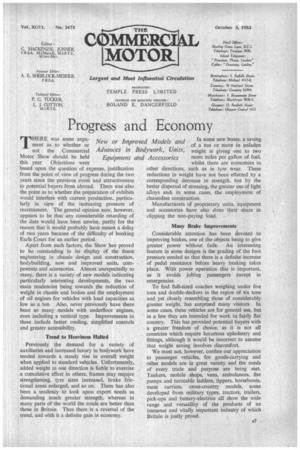Progress and Economy
Page 41

If you've noticed an error in this article please click here to report it so we can fix it.
rERE was some argument as to whether or New or Improved Models and not the Commercial Advances in Bodywork, Units, Motor Show should be held Equipment and Accessories this year Objections were based upon the question of expense, justification from the point of view of progress during the two years since the previous event and attractiveness to potential buyers from abroad. There was also the point as to whether the preparation of exhibits would interfere with current production, particularly in view of the increasing pressure of rearmament. The general opinion now, however, appears to be that any considerable retarding of the date would have been unwise, partly for the reason that it would probably have meant a delay of two years because of the difficulty of booking Earls Court for an earlier period.
Apart from such factors, the Show has proved to be outstanding in its display of the finest engineering in chassis design and construction, bodybuilding, new and improved units, components and accessories. Almost unexpectedly to many, there is a variety of new models indicating particularly interesting developments, the two main tendencies being towards the reduction of weight in chassis and bodies and the employment of oil engines for vehicles with load capacities as low as a ton. Also, never previously have there been so many models with underfloor engines, even including a vertical type. Improvements in these include better cooling, simplified controls and greater accessibility.
Trend to Heaviness Halted Previously the demand for a variety of auxiliaries and increased luxury in bodywork have tended towards a steady rise in overall weight when applied to standard vehicles. Unfortunately, added weight in one direction is liable to exercise a cumulative effect in others, frames may require strengthening, tyre sizes increased, brake frictional areas enlarged, and so on. There has also been a tendency to look upon export needs as demanding much greater strength, whereas in many parts of the world the roads are better than those in Britain. Thus there is a reversal of the trend, and with it a definite gain in economy. In some new buses, a saving of a ton or more in unladen weight is giving one to two more miles per gallon of fuel, whilst there are economies in other directions, such as in tyre wear. These reductions in weight have not been effected by a corresponding decrease in strength, but by the better dispersal of stressing, the greater use of light alloys and, in some cases, the employment of chassisless construction.
Manufacturers of proprietary units, equipment and accessories have also done their share in clipping the non-paying toad.
Many Brake Improvements Considerable attention has been devoted to improving brakes, one of the objects being to give greater power without fade. An interesting feature in some designs is the grading of the foot pressure needed so that there is a definite increase of pedal resistance before heavy braking takes place. With power operation this is important, as it avoids jolting passengers except in emergencies.
To find full-sized coaches weighing under five tons and double-deckers in the region of six tons and yet closely resembling those of considerably greater weight, has surprised many visitors. In some cases, these vehicles are for general use, but in a few they are intended for work in fairly flat country. This has provided potential buyers with a greater freedom of choice, as it is not all countries which require luxurious upholstery and fittings, although it would be incorrect to assume that weight saving involves discomfort.
We must not, however, confute our appreciation to passenger vehicles, for goods-carrying and other models are in great variety and the needs of every trade and purpose are being met. Tankers, mobile shops, vans, ambulances, fire pumps and turntable ladders, tippers, horseboxes, meat carriers, cross-country models, some developed from military types, tractors, trailers, pick-ups and battery-electrics all show the wide range and versatility of the products of an immense and vitally important industry of which Britain is justly proud.




















































































































































